Author: JONASCYANG
Compilation: Deep Tide TechFlow
In the field of digital asset trading, perpetual trading, as a derivative market, has become an important part of the cryptocurrency market. This article will delve into the latest developments in the perpetual trading market, with a special focus on a promising new protocol in the Solana ecosystem: Drift Protocol. By analyzing the core design, technical features, and positioning within the Solana ecosystem of Drift Protocol, we can better understand the current situation and future development direction of the perpetual trading field.
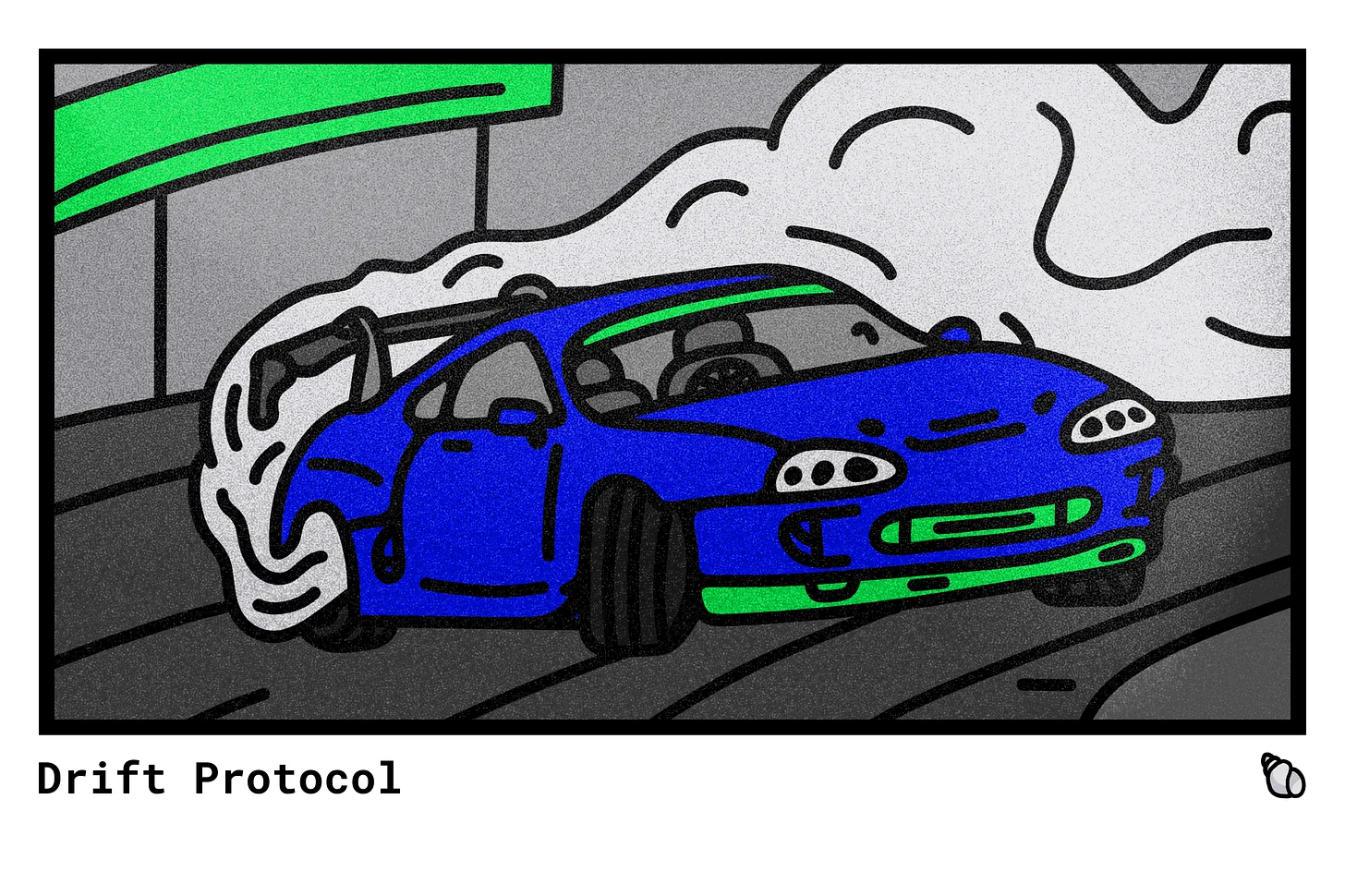
Current Status of Perpetual Trading
In the field of perpetual trading, centralized exchanges still dominate, but it is undeniable that decentralized perpetual protocols have rapidly developed in the past two years, with the total open interest achieving nearly a 10-fold increase.
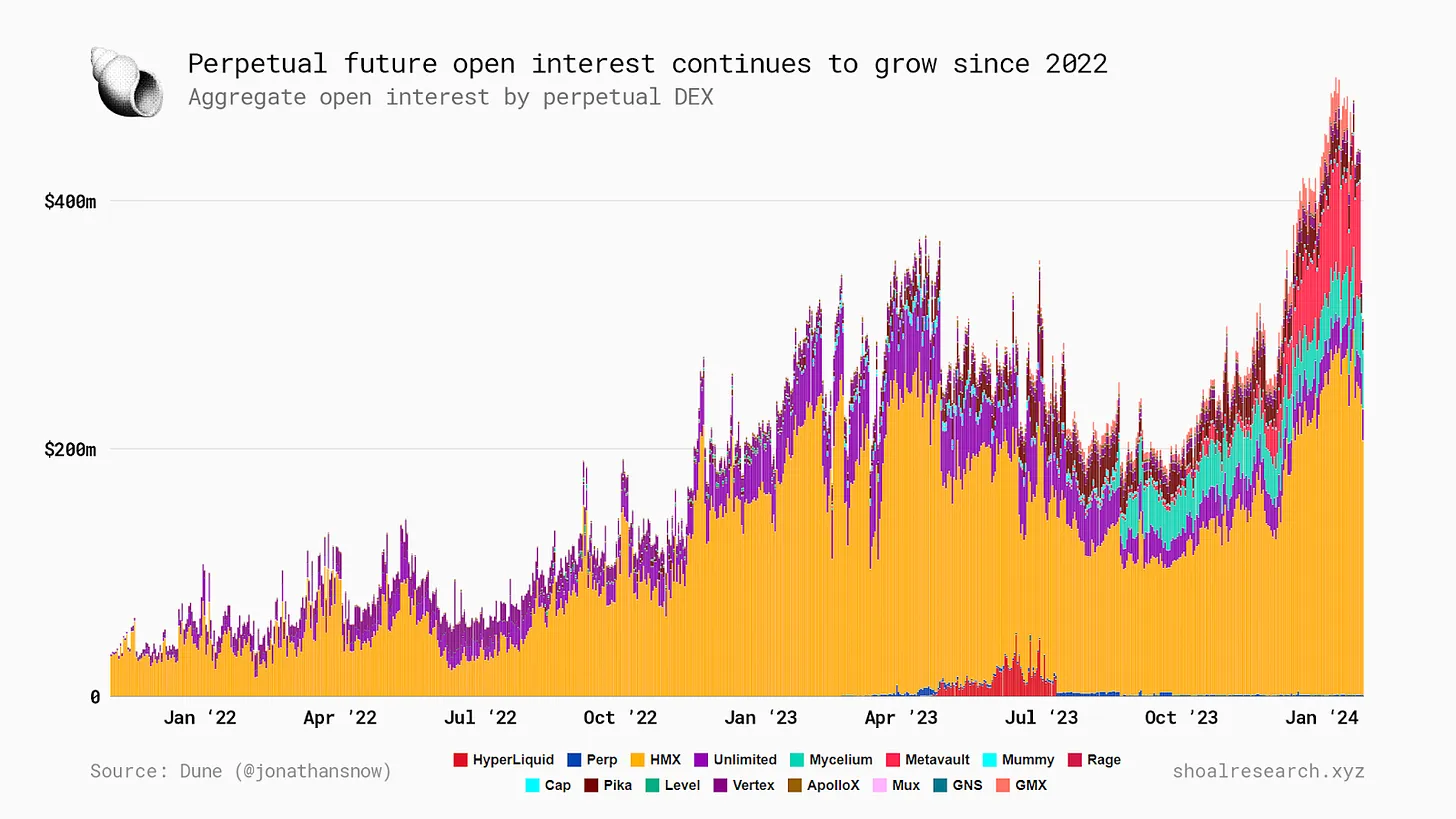
Data does not include DYDX
In this context, competition among perpetual protocols is extremely fierce. The rapid growth in trading volume has led developers to view CEX as a profitable and sustainable business. Many protocols have innovated on a small scale based on GMX and DYDX, such as in the areas of price sources, trading fee structures, and user incentives.
Just like DEX, there are numerous branches in every DeFi field. The excessive branching in the perpetual protocol field has intensified competition because the business structure is too simple. Currently, if the liquidity of perpetual protocols is not utilized to develop DeFi, it will miss a great opportunity.
Introduction to Drift Protocol
Drift is building a decentralized perpetual protocol on Solana using the dynamic vAMM (DAMM) mechanism. Drift v2 was launched in mid-2022 and has grown into one of the top 5 perpetual CEXs due to its new hybrid liquidity solution. Drift Protocol has operated successfully for 2 years without a native token, standing out in the process. Drift Protocol provides various types of derivative markets, including perpetual contracts, spot, and lending.
Driftv1 and Its Issues
vAMM
In most cases, automated market makers (AMMs) are used for swaps, also known as spot trading. Traditionally, AMMs use the constant product formula x * y=k to price assets, where x and y represent the reserve balances of two assets in the liquidity pool, and k represents the total liquidity. The key concept here is that, due to automatic rebalancing, k remains constant throughout the entire trading process.
Perpetual Protocol is another perpetual exchange based on AMM, which initially proposed a solution called virtual automated market maker or vAMM based on AMM. Unlike traditional AMMs, vAMM trading does not depend on underlying assets. Although it uses the same x * y=k formula, it is important to note that in the vAMM model, k is predetermined and fixed in the vAMM model, as all trades occur within this virtual pool.
For example, if a user wants to use 1000 USDC to leverage 5 times on SOL, they need to send 1000 USDT to a treasury. In return, the protocol credits 5000 vUSDC to purchase SOL in the vAMM, and then they will have a corresponding SOL exposure.
Drift v1 was built on this concept, with two innovations: re-pegging and liquidity adjustment. Re-pegging means updating the price of quoted assets effectively based on the oracle price (asset price) to facilitate trading in a deeper liquidity area. By being in a deeper liquidity area, trades are executed better. The oracle provides price data to the vAMM and sets it as the latest "terminal (initial) price," and the collected fees are added to the pool to meet the price adjustment, ensuring there is enough liquidity within the adjusted active price range. In the initial vAMM model, when creating a pool, the parameter "k" is set at the time of pool creation. However, in Drift v1, "k" can be adjusted multiple times. In simple terms, to further deepen liquidity, accrued trading fees are injected into the vAMM pool, similar to adding liquidity for Uniswap v2, resulting in an increase in "k."
Issues
In the traditional spot-AMM or Peer-to-Pool model, there is always one party acting as a passive liquidity provider (LP), and traders' profits come from these passive LPs. However, in the case of vAMM without passive LPs, traders act as LPs to each other, meaning for one trader to profit, there must be another trader as the counterparty. Therefore, no one wants to be the last trader. As a result, most people tend to strategically open and close positions to execute arbitrage strategies, ultimately creating a player versus player (PVP) market.
If there are always a large number of traders, such a PVP market can continue to operate normally. However, when arbitrageurs cannot make enough profit, the market may collapse, which is the problem. The preset 'k' sets the initial price. When the current price is higher than the initial price, the position is net long, and vice versa. In most cases, fair prices are driven by CEX, so vAMM pools need to use collected trading fees to reprice when the fair price deviates from the initial price. However, at the same time, funding fees are paid with collected trading fees. When the deviation becomes larger, the costs of re-pegging and k adjustment increase. Although there is a limit to funding fees, the costs of re-pegging and k adjustment may deplete the insurance fund, and then the profits obtained by arbitrageurs decrease.
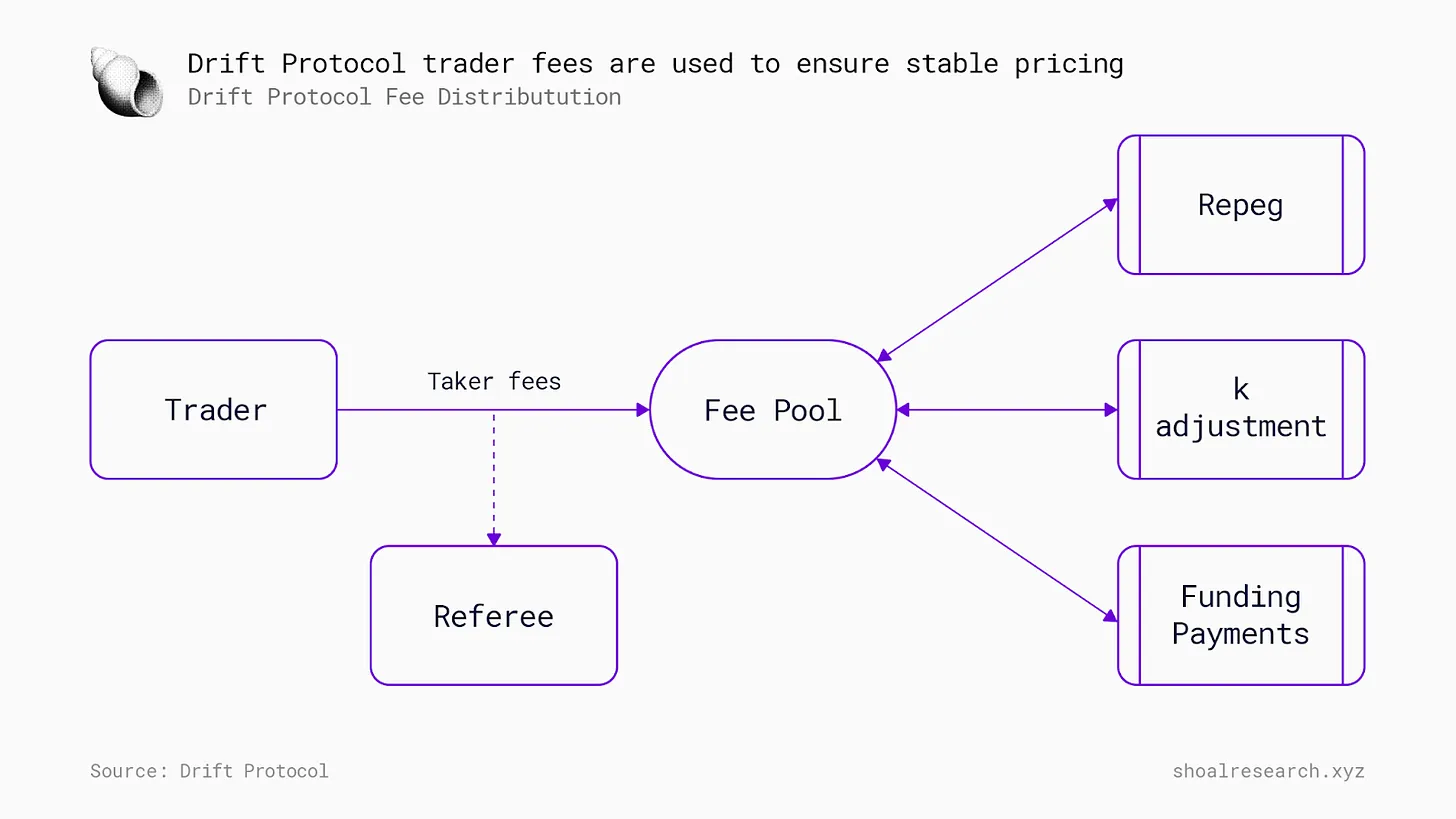
If arbitrageurs leave because the returns are no longer attractive, most of the collected fees are used to provide "better" prices for retail traders. The problem is: without arbitrageurs, there is no trading volume, and no fees.
Due to the asymmetric trading model of vAMM, if leverage is mismanaged, funds may be lost due to price manipulation. Manipulators may be allowed to open two high-leverage positions in succession, pushing the price to a point where the profit from one position can cover the loss from another position; this profit comes from other users' funds. In addition, the difference between positive and negative profits and losses may lead to bankruptcy.
Core Design of Drift v2
Drift v2 introduces a hybrid liquidity solution aimed at providing more collateral and reducing the risk of vAMM itself when executing orders, providing traders with the best prices:
- Just in time (JIT) liquidity
- vAMM liquidity
- Decentralized order book (DLOB) liquidity
Just in Time Liquidity
When a trader submits a market order, it is broadcast to a market maker network composed of guardians and initiates a Dutch auction. By default, the Dutch auction lasts for 5 seconds (20 time slots), and the starting price is determined by the oracle price and the inventory status of vAMM. During this process, market makers continuously compete, with the price changing from most favorable to least favorable for the recipient. The JIT auction provides traders with the opportunity to experience zero slippage in trading activity.
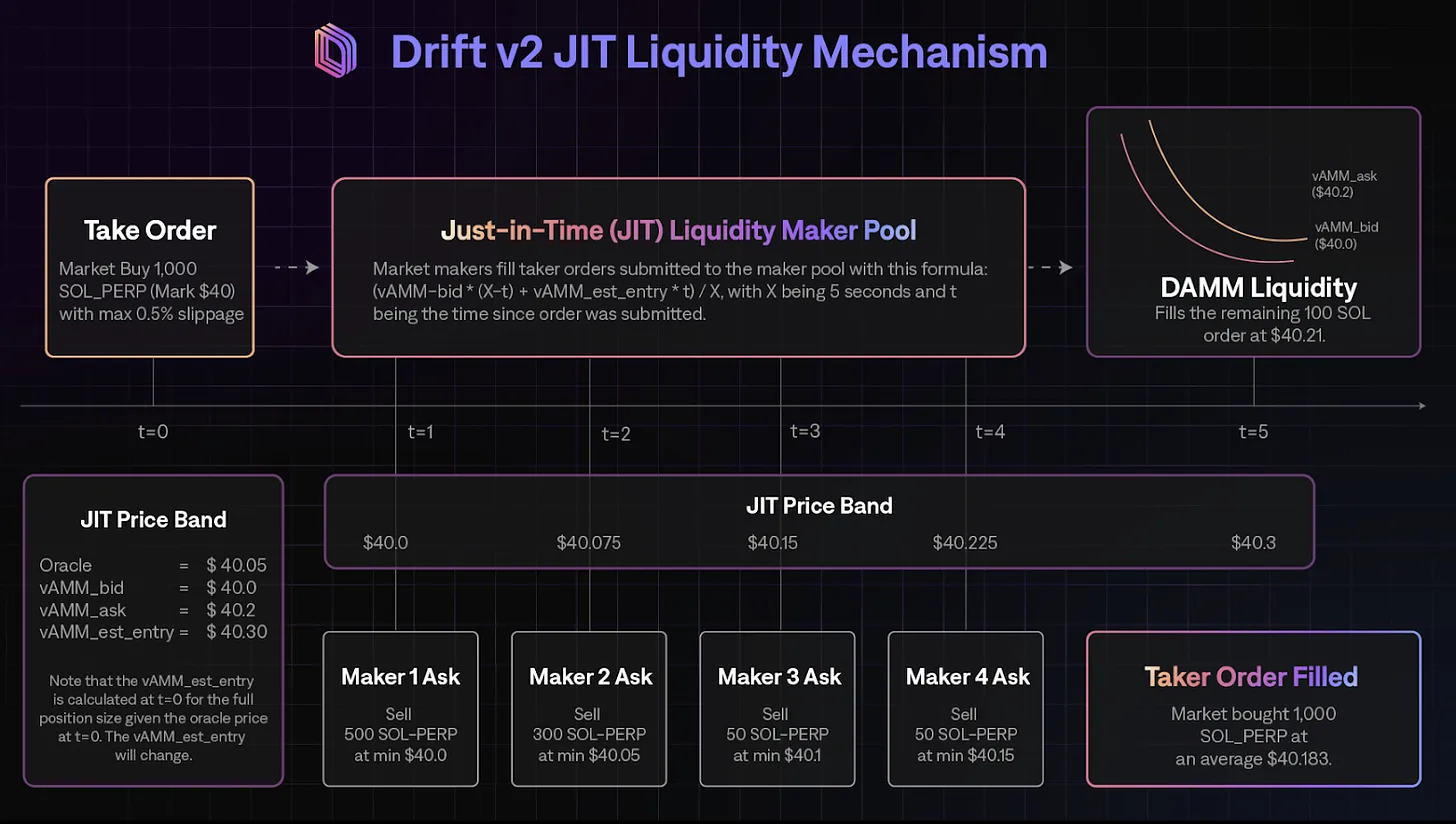
vAMM Liquidity
In Drift v2, if there are no market makers executing market orders, vAMM will act as backup liquidity. Drift v2's AMM has built-in bid-ask spreads and Drift Liquidity Providers (DLP). DLPs are passive liquidity providers with an active function, opening relative positions with vAMM. Users can add liquidity to specific pools and receive a share of the fees they accept. The built-in bid-ask spread allows Drift vAMM to have broader liquidity, not just filling at the current oracle price during auctions. This process alleviates the high-cost long-short imbalance issue.
Whether based on vAMM or on the oracle, perpetual markets are always a zero-sum game, with traders profiting from others' losses. This contrasts with v1, where traders had "real" liquidity for their P&L, which is important as it provides more collateral. After integrating DLP into DAMM, liquidity depth will be improved by increasing "k," and 80% of trading fees will be allocated as rewards to DLP.
Drift v2 also introduces a new oracle-based pricing mechanism that optimizes the repricing and spread setting process by considering factors such as volatility and inventory. This ensures arbitrageurs participate in activities to effectively balance long and short positions. Price movements in v2 depend on data provided by the oracle, rather than long-short imbalances.
Decentralized Order Book (DLOB) Liquidity
Drift v2 provides a decentralized order book network. The mechanism behind it is simple: a group of robots called Keepers is responsible for recording, storing, and matching and executing submitted limit orders. Each Keeper robot has its own off-chain order book. Orders are sorted by price, time, and position size. When an order reaches the trigger price, the Keeper submits the trade to counter DAMM. In return, the Keeper receives trading fees based on a mathematically determined ratio, which is further explained here. It is worth noting that if there are buy and sell orders with exactly the same parameters (e.g., buying 1 SOL for 110 USDC—selling 1 SOL for 110 USDC), Keepers can match them directly without going through vAMM, which can improve efficiency.
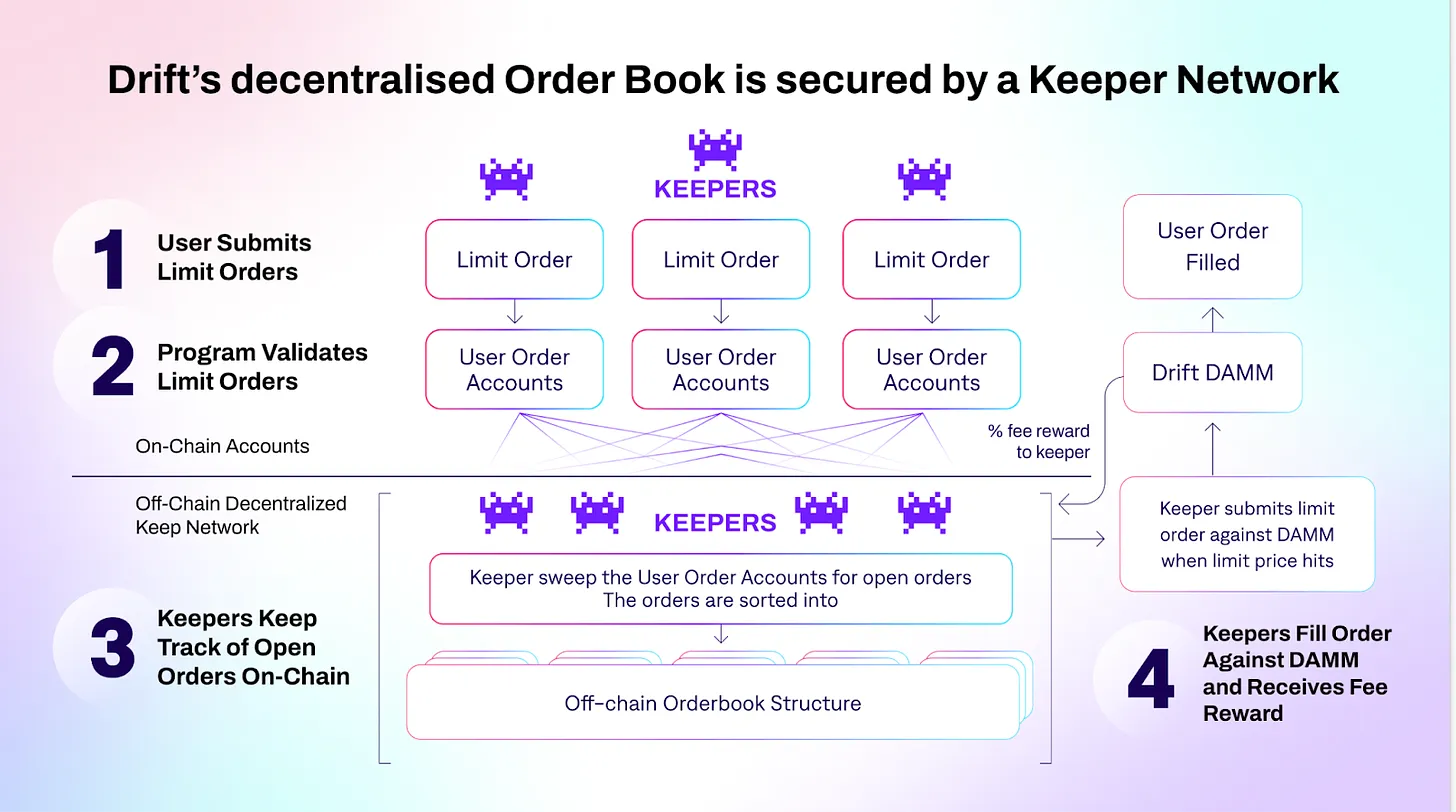
Overall, to address solvency issues, Drift v2 decentralizes order execution to real liquidity sources, such as JIT, DLP, and direct order matching in DLOB (which also means more collateral).
Other Features
Spot
Drift v2 offers spot trading and spot margin trading. Unlike perpetual trading, all types of spot trading are based on real underlying assets. For example, liquidity for spot trading comes from OpenBook DEX. Additionally, spot and margin trading allow users to increase their spot leverage by borrowing assets on Drift v2. The primary purpose of these two methods is to hedge perpetual positions.
Swap
The exchange on Drift relies on Jupiter routing to provide users with the best prices. However, liquidity comes from Drift v2 itself. Users can also use flash loans to increase leverage for swaps.
Lending
Drift's lending module is similar to Aave, using an over-collateralization mechanism. When you deposit assets into Drift, those assets automatically generate yield.
Growth Catalysts
Incentive Expectations
Drift launched its v1 in 2021. Up to now, Drift still does not have its own native token, missing the opportunity to incentivize users to onboard the protocol. Despite this, Drift v2 has achieved over $5 billion in total trading volume and nearly 100,000 users.
On January 24, 2024, Drift announced that it would also become a member of points-meta, launching its own points system for a period of three months. Drift has a strong team and a history of rapid product iteration. We believe that after the points system is launched, the Drift protocol will gain a larger market share and trading volume.

Solana Arguments
Solana's recovery in 2023 is exciting, especially towards the end of last year.
- High-quality projects like Jito have brought more liquidity to Solana.
- Due to Solana's technical advantages, meme also experienced a boom, with Bonkbot earning $10 million in fees in December, and BananaGun launching its own Solana version.
- Depin and RWA narratives have brought more exposure to Solana.
The prosperity of the Solana ecosystem, resulting in increased TVL, users, and on-chain activity, will be the fundamental driving force for the growth of the Drift protocol. Drift will have more opportunities to capture the revenue generated by DeFi protocols, and the introduction of active assets will bring demand for leveraged trading.
Potential Opportunities
We have observed many perpetual DEXs growing with different strategies. Drift's leadership position in the Solana ecosystem is one of its biggest advantages. Since the meme season began, more and more long-tail assets have appeared with significant trading volume and good liquidity. If Drift can list more popular tokens like HyperLiquid, Drift could become a major degenerate hub on Solana.
Drift v2's TVL is currently $171 million, ranking 5th in the derivatives category on DeFiLlama. DLP accounts for approximately $16 million of Drift v2's TVL. Market maker treasury represents $16 million, and insurance fund treasury $10 million. The remaining TVL consists of assets deposited by depositors. Drift currently serves 133,000 users and has facilitated over 9.4 million trades, indicating that Drift v2 has sufficient assets and user base.

Although the daily trading volume is between $50 million and $100 million, it still lags significantly behind competitors in other ecosystems. At the same time, the lack of trading willingness makes the revenue generated by sub-products less attractive to users. We believe that with the launch of Drift's incentive program, trading will improve. As a Series A product, it is worth noting that the higher profit growth brought by token incentives can increase the base income of depositors, creating a flywheel effect.
Conclusion
From v1 to v2, we can see a clear trend of improvement in Drift vAMM solutions in continuously adding real liquidity and strengthening the intervention of oracles in pricing. Although this seems to negate the original design concept of vAMM, the combination of real liquidity and vAMM can provide users with a better experience when trading long-tail assets. With tokens and a points system, Drift will become increasingly profitable.
However, Drift also has significant drawbacks. Thanks to Solana's high performance, the hybrid liquidity solution also turns trading on Drift into a flow pattern. Therefore, Keepers and DLPs as liquidity providers do not have equal footing in executing trades, making DLP less attractive. We believe that the upcoming tokens may bring more possibilities for improvement to Drift.
免责声明:本文章仅代表作者个人观点,不代表本平台的立场和观点。本文章仅供信息分享,不构成对任何人的任何投资建议。用户与作者之间的任何争议,与本平台无关。如网页中刊载的文章或图片涉及侵权,请提供相关的权利证明和身份证明发送邮件到support@aicoin.com,本平台相关工作人员将会进行核查。




